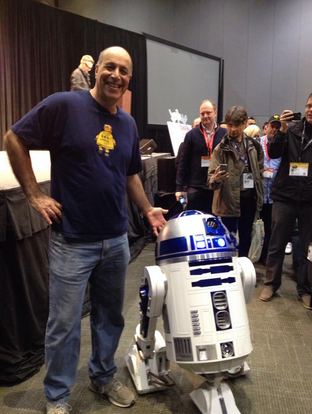Industry people regularly ask me to recommend a knowledgeable and entertaining speaker to address an audience of manufacturers. One person I routinely suggest is Carl Bass, the former CEO of Autodesk.
I heard the forward-looking, funny, Cornell University mathematics major speak at a conference in November 2013. Bass, who resigned his Autodesk post Feb. 7 but remains on the company’s board, talked about innovation.

Carl Bass, who recently resigned as CEO of Autodesk, says he’s going to spend "time in my shop with my robots." This photo was taken as SXSW 2014. Image courtesy Shapeways, www.shapeways.com.
Manufacturing “used to focus on quality,” said Bass, who oversaw major advancements in 3D design and engineering software during his 24-year tenure at Autodesk. “Now, the focus is on innovation (‘How can I differentiate myself from my competitors?’).”
During the presentation, he predicted five trends that will drive innovation.
- The move from owning something to accessing experience. (“People don’t want to own a DVD; they just want to experience watching a movie.”)
- “Business ‘un-usual’ ” (financing options like Kickstarter).
- Digital fabrication (3D printing).
- Accessing information anywhere at any time on many types of devices.
- Ever-cheaper, more-powerful computers.
Despite more than 3 years passing since Bass made the predictions, they still sound fresh. (To judge for yourself, view Bass’ 2013 TED Talk by clicking here www.youtube.com/watch?v=yRcDCGtf06c.)
As for what’s next for Bass, he wrote in a blog posted to the Autodesk website, “I am not leaving to spend more time with my family—that presumes my family wants to spend more time with me. I will, however, be spending more time in my shop with my robots.”
Turning serious, he continued: “When I first became CEO, people asked how I wanted to define Autodesk and I often answered somewhat cryptically, ‘great, good and important.’ In my mind, great companies are defined, first and foremost, by their financial performance. Good companies are defined by their values and culture and how they treat their employees, their customers and the communities in which they do business. And important companies make a real difference in the world.
“Being able to do all three is the most critical and difficult task any executive team faces. By almost any measure, I think we’ve done very well on all fronts,” Bass wrote.
I do, too.
Related Glossary Terms
- turning
turning
Workpiece is held in a chuck, mounted on a face plate or secured between centers and rotated while a cutting tool, normally a single-point tool, is fed into it along its periphery or across its end or face. Takes the form of straight turning (cutting along the periphery of the workpiece); taper turning (creating a taper); step turning (turning different-size diameters on the same work); chamfering (beveling an edge or shoulder); facing (cutting on an end); turning threads (usually external but can be internal); roughing (high-volume metal removal); and finishing (final light cuts). Performed on lathes, turning centers, chucking machines, automatic screw machines and similar machines.


 ARTICLES
ARTICLES



